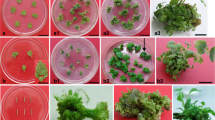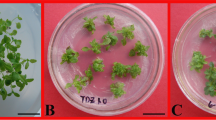Abstract
An efficient system for micropropagation using leaf explants was established in a high-grade Chinese medicinal herb, Salvia miltiorrhiza Bunge. A high morphogenetic plasticity was found in the leaf explants, and it showed four types of in vitro morphogenesis, including direct rhizogenesis, indirect rhizogenesis, direct shoot formation and indirect shoot formation. In direct organogenesis, a significantly higher number of shoots was obtained in the presence of 0.1 or 0.5 mg/L TDZ and a significantly higher number of roots was obtained in the plant growth regulator-free (PGR-free) treatment, respectively. In indirect organogenesis, the ratio of NAA to BA showed a significant effect and it followed the regular pattern on in vitro organogenesis that higher ratios promote rooting and lower ratios promote shoot formation from the callus. Generally, in S. miltiorrhiza, the application of TDZ could induce effective responses including induction of direct and indirect shoot formation and also callogenesis when it combined with 2,4-D. In callogenesis, 16 callus lines were induced and maintained, and significant differences of proliferation rate and redifferentiation capacity were found between several lines of the calli. Therefore, it could promote efficiency of regeneration pathway by selecting appropriate callus lines. According to these results, a two-step protocol via direct shoot formation and another four-step protocol via indirectly shoot formation were developed for obtaining regenerated plantlets. The requirements and characteristics of these two regeneration protocols were compared thoroughly, and either has its advantages and applications. Eventually, the regenerated plants had a 100 % survival rate after 45 days of acclimatization. The chemical contents of the regenerated plants were proved by high-performance liquid chromatography, and the extract of the root contained all the major medicinal constituents, including salvianolic acid B, dihydrotanshinone I, cryptotanshinone, tanshinone I and tanshinone IIA. The in vitro culture system established in this study has various aspects of applications including mass propagation and production of tanshinones. It may provide an efficient model for further investigating on the mechanism of organogenesis in S. miltiorrhiza, especially direct rhizogenesis from leaf explants without the supplement of exogenous PGRs.




Similar content being viewed by others
Abbreviations
- 2,4-D:
-
2,4-Dichlorophenoxyacetic acid
- BA:
-
N 6-Benzyladenine
- IBA:
-
Indole-3-butyric acid
- MS medium:
-
Murashige and Skoog (1962) medium
- NAA:
-
1-Naphthaleneacetic acid
- PGRs:
-
Plant growth regulators
- TDZ:
-
1-Phenyl-3-(1,2,3-thiadiazol-5-yl)-urea, thidiaruzon
References
Bajaj S, Rajam MV (1995) Efficient plant regeneration from long-term callus cultures of rice by spermidine. Plant Cell Rep 14:717–720
Chen JT (2012) Induction of petal-bearing embryos from root-derived callus of Oncidium ‘Gower Ramsey’. Acta Physiol Plant 34:1337–1343
Chuang MT, Ho FM, Wu CC, Zhuang SY, Lin SY, Suk FM, Liang YC (2011) 15,16-Dihydrotanshinone I, a compound of Salvia miltiorrhiza Bunge, induces apoptosis through inducing endoplasmic reticular stress in human prostate carcinoma cells. Evid Based Complement Alternat Med 2011:865435
Duncan DB (1955) Multiple range and multiple F test. Biometrics 11:1–42
Gantait S, Sinniah UR (2014) In vitro direct rhizogenesis from Gerbera jamesonii Bolus leaf. Acta Physiol Plant 36:3081–3087
Gao SL, Zhu DN, Cai ZH, Xu DR (1996) Autotetrapolid plants from colchicine-treated bud culture of Salvia miltiorrhiza. Plant Cell Tissue Org Cult 47:73–77
Guo B, Abbasi BH, Zeb A, Xu LL, Wei YH (2011) Thidiazuron: a multi-dimensional plant growth regulator. Afr J Biotechnol 10:8984–9000
Gupta SK, Liu RB, Liaw SY, Chan HS, Tsay HS (2011) Enhanced tanshinone production in hairy roots of ‘Salvia miltiorrhiza Bunge’ under the influence of plant growth regulators in liquid culture. Bot Stud 52:435–443
Gürel E, Wren MJ (1995) In vitro development from leaf explants of sugar beet (Beta vulgaris L). rhizogenesis and the effect of sequential exposure to auxin and cytokinin. Ann Bot 75:31–38
Lee PL, Chen JT (2014) Plant regeneration via callus culture and subsequent in vitro flowering of Dendrobium huoshanense. Acta Physiol Plant 36:2619–2625
Murashige T, Skoog F (1962) A revised medium for rapid growth and bioassays with tobacco tissue cultures. Physiol Plant 15:473–497
Murthy BNS, Murch SJ, Saxena PK (1998) Thidiazuron: a potent regulator of in vitro plant morphogenesis. In Vitro Cell Dev Biol Plant 34:267–275
Rout GR, Samantaray S, Das P (1998) In vitro selection and characterization of Ni-tolerant callus lines of Setaria italica L. Acta Physiol Plant 20:269–275
Shimomura K, Kitazawa T, Okamura N, Yagi A (1991) Tanshinone production in adventitious roots and regenerates of Salvia miltiorrhiza. J Nat Prod 54:1583–1587
Skoog F, Miller CO (1957) Chemical regulation of growth and organ formation in plant tissues cultured in vitro. Symp Soc Exp Biol 11:118–131
Smigocki AC, Owens LD (1989) Cytokinin-to-auxin ratios and morphology of shoots and tissues transformed by a chimeric isopentenyl transferase gene. Plant Physiol 91:808–811
Smulders MJM, de Klerk GJ (2011) Epigenetics in plant tissue culture. Plant Growth Regul 63:137–146
Suk FM, Jou WJ, Lin RJ, Lin SY, Tzeng FY, Liang YC (2013) 15,16-Dihydrotanshinone I-induced apoptosis in human colorectal cancer cells: involvement of ATF3. Anticancer Res 33:3222–3231
Thorpe TA (1994) Morphogenesis and regeneration. In: Vasil IK, Thorpe TA (eds) Plant cell and tissue culture. Kluwer Academic, Dordrecht, pp 17–36
Von Arnold S, Sabala I, Bozhkov I, Dyachok J, Filonoval L (2005) Developmental pathways of somatic embryogenesis. Plant Cell Tissue Org Cult 69:233–249
Wadegaonkar PA, Bhagwat KA, Rai MK (2006) Direct rhizogenesis and establishment of fast growing normal root organ culture of Withania somnifera Dunal. Plant Cell Tissue Org Cult 84:223–225
Wang JW, Wu JY (2010) Tanshinone biosynthesis in Salvia miltiorrhiza and production in plant tissue cultures. Appl Microbiol Biotechnol 88:437–449
Wang J, Xiong X, Feng B (2013a) Cardiovascular effects of salvianolic acid B. Evid Based Complement Alternat Med Article ID 247948, 16 pages
Wang QJ, Zheng LP, Yuan HY, Wang JW (2013b) Propagation of Salvia miltiorrhiza from hairy root explants via somatic embryogenesis and tanshinone content in obtained plants. Ind Crop Prod 50:648–653
Zhang HS, Wang SQ (2006) Salvianolic acid B from Salvia miltiorrhiza inhibits tumor necrosis factor-α (TNF-α)-induced MMP-2 upregulation in human aortic smooth muscle cells via suppression of NAD(P)H oxidase-derived reactive oxygen species. J Mol Cell Cardiol 41:138–148
Zheng S, Henken B, Sofiari E, Keizer P, Jacobsen E, Kik C, Krens F (1999) Effect of cytokinins and lines on plant regeneration from long-term callus and suspension cultures of Allium cepa L. Euphytica 108:83–90
Acknowledgments
The authors are very grateful to the financial support from National University of Kaohsiung, and the technical support in HPLC from Biotechnology Division, Taiwan Agricultural Research Institute.
Author information
Authors and Affiliations
Corresponding author
Additional information
Communicated by E. Dziedzic.
Rights and permissions
About this article
Cite this article
Tsai, KL., Chen, E.G. & Chen, JT. Thidiazuron-induced efficient propagation of Salvia miltiorrhiza through in vitro organogenesis and medicinal constituents of regenerated plants. Acta Physiol Plant 38, 29 (2016). https://doi.org/10.1007/s11738-015-2051-0
Received:
Revised:
Accepted:
Published:
DOI: https://doi.org/10.1007/s11738-015-2051-0




